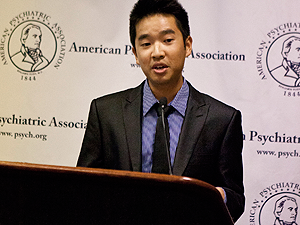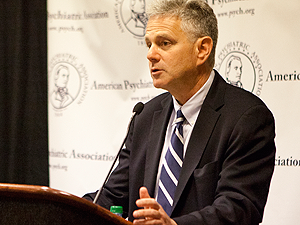Deborah Brauser
|
|
A study presented here at the American Psychiatric Association's (APA's) 2012 Annual Meeting showed that almost 90% of the youth receiving treatment for drug addiction reported using social networking sites, such as Facebook and Twitter. The majority also reported that exposure to "drug cues" posted on these sites made them want to use drugs themselves.
"These results tell us that these exposures may negatively impact treatment outcomes among adolescents," lead author David Tran, medical student at the David Geffen School of Medicine at the University of California–Los Angeles (UCLA) and from the UCLA Luskin School of Public Affairs, told Medscape Medical News after a press briefing.

|
|
David Tran
|
He noted that the investigators hope to next look at implementing an online intervention at a substance abuse center, along with the usual treatment plan.
"We want to build a Facebook group to engage youth, bring in discussions, provide needed information, and increase the number of non–drug users in their social networks. Hopefully this will mitigate the online risks we found," he said.
Influence of Drug Cues
Social networks often include coworkers, family members, and friends — all of whom can exercise substantial influence, said Tran.
Although previous research has shown that online sites can influence use of illegal substances in adults, "exposures that may prompt relapse in adolescents" have not yet been assessed.
For this study, Tran and colleagues enrolled 37 youth between the ages of 12 and 18 years. All participants, who were in a substance abuse treatment program at an adolescent treatment center in a predominantly Latino section of East Los Angeles, received a 20-question questionnaire.
The survey included questions about demographics, drug of choice, use of online social networking sites, and exposures to drug-related cues while online.
Results showed that 89% of the participants reported using online social networking sites during treatment. Of these, 94% reported using Facebook.
Marijuana was the drug of choice for 88% of the adolescents. The next most common drugs of choice (in order of frequency of use) were ecstasy, inhalants, methamphetamine, and cocaine for the girls and ecstasy, cocaine, and inhalants/methamphetamine for the boys.
All of the girls and 88% of the boys reported that their friends on Facebook, Twitter, or MySpace use drugs.
In addition, 94% of the participants reported that their friends posted comments about drug-related content, whereas only 44% reported that they posted drug-related content themselves. Only 22% reported seeing postings from friends about recovery or drug education.
Seeing online postings that made the participants feel that they wanted to use drugs themselves were reported by 66% of the participants (77% of the girls, 53% of the boys).
Tran noted that he is looking forward to the next step of the study, which is building the Facebook group intervention.
"Cutting off Internet access or access to online social networking sites wouldn't really work. Kids will find a way to get online with their cell phones, at home, or at their schools," he said.
"So we want to take this opportunity to positively work with kids and empower them in a way that helps them to make healthy and educated decisions about their lives."
He reported that past research has shown that online social support through Alcoholics Anonymous groups increased treatment retention rates.
"We want kids to know that they can quit and there is support out there. For kids who are coming from underserved areas, the resources are lacking. So we want to look at the feasibility and sustainability of setting up these groups and training peer leaders/educators," said Tran.
Potential for Harm
"I think social media has tremendous potential to help. But from this study, we see that it also has potential to harm," press conference moderator Jeffrey Borenstein, MD, medical director of Holliswood Hospital in New York City and chair of the APA Council on Communications, told Medscape Medical News.

|
|
Dr. Jeffrey Borenstein
|
"One is with peer support, especially for treatment of chemical dependency. For our younger generation, who are used to interacting through Facebook, including peer support while making use of the technology has the potential to be really helpful."
He said that the other key area is in education, by explaining the risks of substance abuse through the technological methods adolescents already commonly use.
"That can make a big difference. And that's why I'm very excited about this study, which is an extraordinary work by somebody who is still in school. I'd say the future of our field is very bright," said Dr. Borenstein.
No comments:
Post a Comment